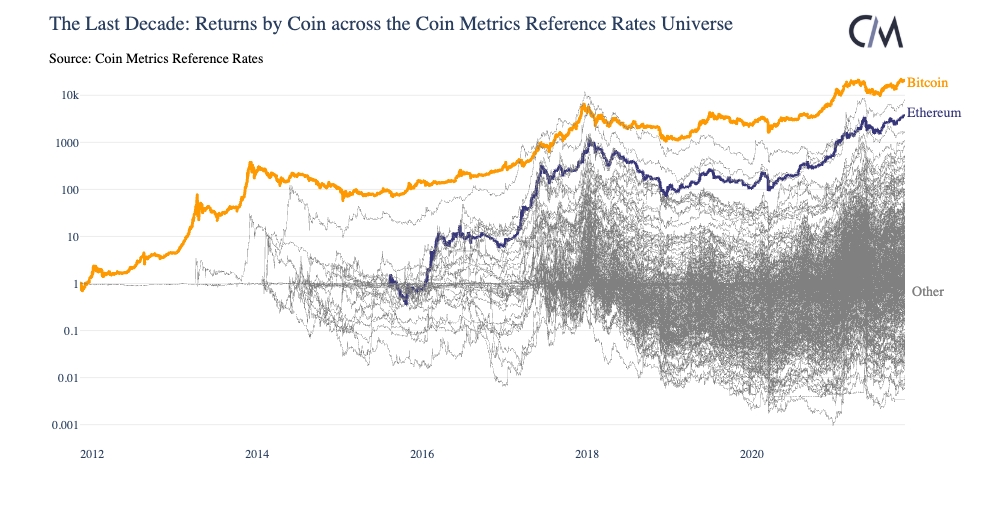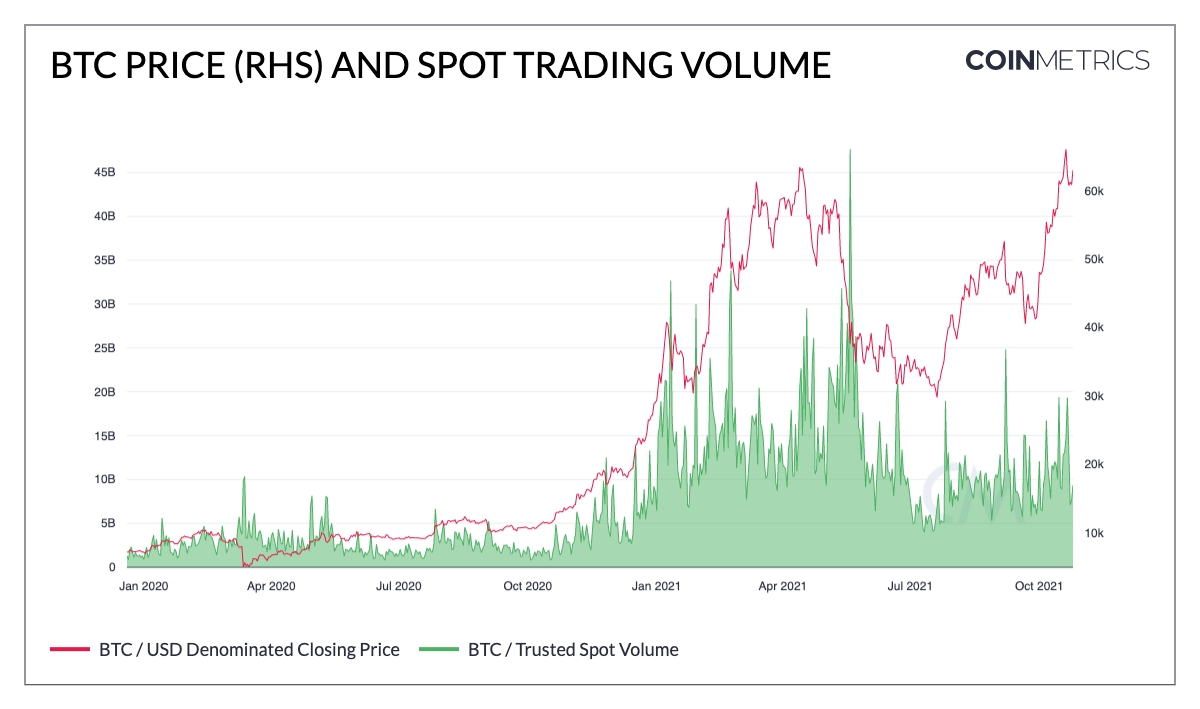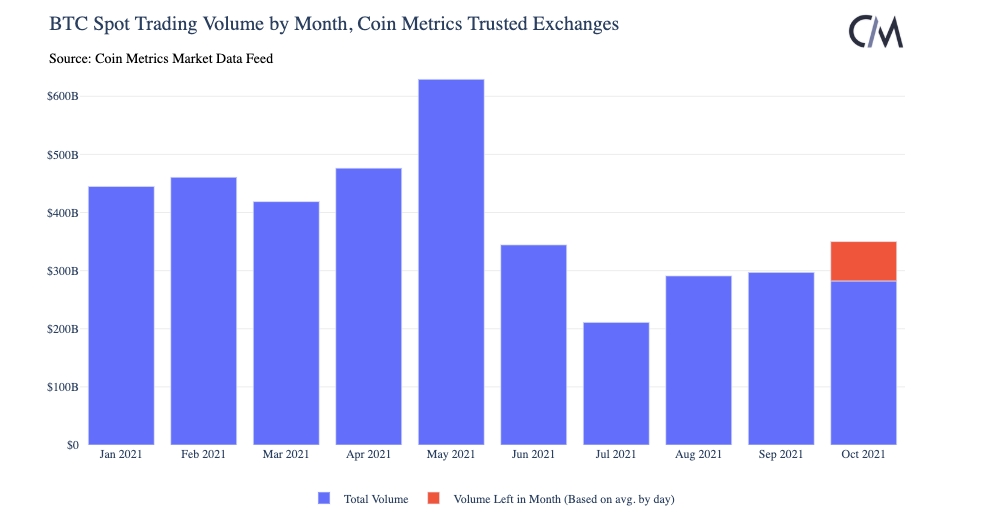Python API Client Walkthrough
Python API Client Walkthrough
Last Updated: Version 2024.08.20
This notebook demonstrates basic functionality offered by the Coin Metrics Python API Client using Coin Metrics Community Data.
Coin Metrics offers a vast assortment of data for hundreds of cryptoassets. The Python API Client allows for easy access to this data using Python without needing to create your own wrappers using requests and other such libraries.
Prerequisites
First, Python must be installed. Download and install from python.org. The Coin Metrics API Client is best used with Python 3.8 or later.
Then, install the Python API Client:
pip install coinmetrics-api-client
Some of the optional libraries such as pandas, numpy, and seaborn are used in the notebook to make the examples more interactive. These libraries are not required to use the Coin Metrics API Client.
You are now ready to run the code in the rest of the notebook.
Resources
To understand the data that Coin Metrics offers, feel free to peruse the resources below.
The Coin Metrics API v4 website contains the full set of endpoints and data offered by Coin Metrics.
The Coin Metrics Product Documentation gives detailed, conceptual explanations of the data that Coin Metrics offers.
The API Spec contains a full list of functions.
The Coverage Tool shows what assets, metrics, and other data types are covered.
Setup
Catalogs
The Coin Metrics API contains two types of catalog endpoints (Python client functions in paranthesis): the catalog (catalog_*_v2) and catalog-all (catalog_full_*_v2).
The catalog endpoint displays the set of data available to your API key. The catalog-all endpoint displays the full set of data for our dataset.
Catalog objects return a list of dictionaries. For catalog_asset_metrics_v2, each element of the list is an asset, while each dictionary is a set of metadata for that specific asset.
For more details on what metrics are covered, see Coverage
Getting Timeseries Data
Next, we will pull timeseries data. Typically there are two types of timeseries data that you can pull: raw observations such as trades and aggregated metrics. We will explore these two below.
Asset Metrics
First, we will use the asset-metrics endpoint to get metrics for BTC and ETH.
You can bound your query by time like below:
0
btc
2024-09-01 00:00:00+00:00
1132518348250.186279
58959.926273
1
btc
2024-09-02 00:00:00+00:00
1168286956855.852539
57349.080718
2
btc
2024-09-03 00:00:00+00:00
1138274882375.744873
59159.023888
3
btc
2024-09-04 00:00:00+00:00
1146114653782.878418
57637.775444
4
btc
2024-09-05 00:00:00+00:00
1108213762229.152832
58033.39897
0
btc
2024-08-15 00:00:00+00:00
1137894996787.05249
58840.64668
1
btc
2024-08-16 00:00:00+00:00
1163252605521.227783
57644.187688
2
btc
2024-08-17 00:00:00+00:00
1172900035803.550781
58927.276509
3
btc
2024-08-18 00:00:00+00:00
1160659435495.434814
59414.674335
4
btc
2024-08-19 00:00:00+00:00
1172894781992.733887
58793.206146

Coin Metrics supports several metrics for various data types such as exchanges, markets, and asset-pairs.
You can also bound your queries by using the limit parameter.
0
btc
2024-09-01 00:00:00+00:00
660770
9283
3046587
20365534
973
1
btc
2024-09-02 00:00:00+00:00
717673
9284
3046904
20359814
972
2
eth
2024-09-01 00:00:00+00:00
548611
6907
1836310
27996184
1221
3
eth
2024-09-02 00:00:00+00:00
488354
6902
1836617
28008369
1218
0
btc
2024-08-15 00:00:00+00:00
715632
9229
3054724
20292616
973
1
btc
2024-08-16 00:00:00+00:00
700335
9231
3055010
20300505
977
2
eth
2024-08-15 00:00:00+00:00
603353
6862
1837926
27972812
1226
3
eth
2024-08-16 00:00:00+00:00
541263
6871
1837366
27962507
1223
Market Observations
The other common timeseries data type that you will encounter are individual observations.
First, we will need to familiarize ourselves with the market convention which we can find on faqs. You can see a full list of markets by using the reference-data endpoint.
0
coinbase-1inch-btc-spot
coinbase
1inch
btc
1inch-btc
1INCH-BTC
spot
<NA>
<NA>
<NA>
...
0.0
0.0
<NA>
0.000016
<NA>
<NA>
False
<NA>
<NA>
<NA>
1
coinbase-aave-btc-spot
coinbase
aave
btc
aave-btc
AAVE-BTC
spot
<NA>
<NA>
<NA>
...
0.000001
0.000001
<NA>
0.000016
<NA>
<NA>
False
<NA>
<NA>
<NA>
2
coinbase-ada-btc-spot
coinbase
ada
btc
ada-btc
ADA-BTC
spot
<NA>
<NA>
<NA>
...
0.0
0.0
<NA>
0.000016
<NA>
<NA>
False
<NA>
<NA>
<NA>
3
coinbase-algo-btc-spot
coinbase
algo
btc
algo-btc
ALGO-BTC
spot
<NA>
<NA>
<NA>
...
0.0
0.0
<NA>
0.000016
<NA>
<NA>
False
<NA>
<NA>
<NA>
4
coinbase-ankr-btc-spot
coinbase
ankr
btc
ankr-btc
ANKR-BTC
spot
<NA>
<NA>
<NA>
...
0.0
0.0
<NA>
0.000016
<NA>
<NA>
False
<NA>
<NA>
<NA>
5 rows × 39 columns
0
coinbase-1inch-btc-spot
coinbase
1inch
btc
1inch-btc
1INCH-BTC
spot
<NA>
<NA>
<NA>
...
<NA>
<NA>
0.0
0.0
<NA>
0.000016
<NA>
<NA>
False
<NA>
1
coinbase-aave-btc-spot
coinbase
aave
btc
aave-btc
AAVE-BTC
spot
<NA>
<NA>
<NA>
...
<NA>
<NA>
0.000001
0.000001
<NA>
0.000016
<NA>
<NA>
False
<NA>
2
coinbase-ada-btc-spot
coinbase
ada
btc
ada-btc
ADA-BTC
spot
<NA>
<NA>
<NA>
...
<NA>
<NA>
0.0
0.0
<NA>
0.000016
<NA>
<NA>
False
<NA>
3
coinbase-algo-btc-spot
coinbase
algo
btc
algo-btc
ALGO-BTC
spot
<NA>
<NA>
<NA>
...
<NA>
<NA>
0.0
0.0
<NA>
0.000016
<NA>
<NA>
False
<NA>
4
coinbase-ankr-btc-spot
coinbase
ankr
btc
ankr-btc
ANKR-BTC
spot
<NA>
<NA>
<NA>
...
<NA>
<NA>
0.0
0.0
<NA>
0.000016
<NA>
<NA>
False
<NA>
5 rows × 37 columns
We can then pass these markets onto the timeseries/market-* endpoints. Below is an example of how to pull individual market trades.
0
coinbase-btc-usd-spot
2024-10-25 15:22:44.919441+00:00
705966854
0.000004
68353.27
2024-10-25 15:22:45.721609+00:00
buy
1
coinbase-btc-usd-spot
2024-10-25 15:22:44.919441+00:00
705966855
0.000012
68353.27
2024-10-25 15:22:45.721609+00:00
buy
2
coinbase-btc-usd-spot
2024-10-25 15:22:44.919441+00:00
705966856
0.002187
68354.37
2024-10-25 15:22:45.721609+00:00
buy
3
coinbase-btc-usd-spot
2024-10-25 15:22:44.919441+00:00
705966857
0.002523
68354.38
2024-10-25 15:22:45.721609+00:00
buy
4
coinbase-btc-usd-spot
2024-10-25 15:22:45.078614+00:00
705966858
0.001043
68353.27
2024-10-25 15:22:45.721609+00:00
buy
0
coinbase-btc-usd-spot
2024-09-13 16:55:02.663733+00:00
691698441
0.008
59491.6
2024-09-13 16:55:03.253369+00:00
sell
1
coinbase-btc-usd-spot
2024-09-13 16:55:02.670644+00:00
691698442
0.008
59491.61
2024-09-13 16:55:03.253369+00:00
buy
2
coinbase-btc-usd-spot
2024-09-13 16:55:03.057923+00:00
691698443
0.001186
59491.61
2024-09-13 16:55:03.771512+00:00
buy
3
coinbase-btc-usd-spot
2024-09-13 16:55:03.143752+00:00
691698444
0.15742
59491.6
2024-09-13 16:55:03.771512+00:00
sell
4
coinbase-btc-usd-spot
2024-09-13 16:55:03.143816+00:00
691698445
0.076281
59491.6
2024-09-13 16:55:03.771512+00:00
sell
Examples from State of the Network
The Python API Client is often used for transforming data for State of the Network. Below are some examples of data transformations done to produce the data visualizations.
Example 1: Get returns by coin in the CM reference rates universe over the last 10-years
In State of the Network #128, we looked at the returns for each asset dating back the last 10 years.

We can generate this data by weaving in the catalog_asset_metrics_v2 and get_asset_metrics endpoint. The code snippets below demonstrate how to do this with a small list of assets.
time
2024-09-26 00:00:00+00:00
1.102137
1.100617
1.069534
1.070347
1.024427
1.030510
2024-09-27 00:00:00+00:00
1.162204
1.118540
1.103424
1.164025
1.046276
1.042040
2024-09-28 00:00:00+00:00
1.165724
1.141772
1.115465
1.222446
1.073526
1.040046
2024-09-29 00:00:00+00:00
1.158667
1.127693
1.115512
1.267128
1.064176
1.084632
2024-09-30 00:00:00+00:00
1.151477
1.119118
1.112921
1.232789
1.056856
1.133519
time
2024-09-09 00:00:00+00:00
1.008826
0.960197
0.932336
0.936040
0.862489
0.930312
2024-09-10 00:00:00+00:00
1.024744
0.990748
0.971026
1.011867
0.885729
0.948722
2024-09-11 00:00:00+00:00
1.024288
0.988299
0.980011
1.001351
0.896031
0.950876
2024-09-12 00:00:00+00:00
1.051865
1.011061
0.975672
0.987734
0.878328
0.940610
2024-09-13 00:00:00+00:00
1.061901
1.036981
0.987831
1.001874
0.885837
0.987858
Example 2: Get daily spot trading volume on Coinbase for USDC markets
In State of the Network #126, we looked at spot volume on trusted exchanges over time.

We can replicate similar data behind chart using just coinbase spot markets at 2021. Here, we derive volume from our get_market_candles endpoint.
0
coinbase-eurc-usdc-spot
2024-08-23 00:00:00+00:00
1.121
1.119
1.121
1.118
1.120121
997787.0
1.117636e+06
140
1
coinbase-eurc-usdc-spot
2024-08-24 00:00:00+00:00
1.12
1.12
1.13
1.119
1.120547
1122215.0
1.257359e+06
412
2
coinbase-eurc-usdc-spot
2024-08-25 00:00:00+00:00
1.121
1.12
1.132
1.119
1.121433
2796276.0
3.135467e+06
1727
3
coinbase-eurc-usdc-spot
2024-08-26 00:00:00+00:00
1.12
1.118
1.126
1.116
1.118883
1999004.0
2.236406e+06
882
4
coinbase-eurc-usdc-spot
2024-08-27 00:00:00+00:00
1.117
1.119
1.122
1.116
1.118849
1505368.0
1.684066e+06
1227
0
coinbase-eurc-usdc-spot
2024-08-23 00:00:00+00:00
1.121
1.119
1.121
1.118
1.120121
997787.0
1.117636e+06
140
1
coinbase-eurc-usdc-spot
2024-08-24 00:00:00+00:00
1.12
1.12
1.13
1.119
1.120547
1122215.0
1.257357e+06
412
2
coinbase-eurc-usdc-spot
2024-08-25 00:00:00+00:00
1.121
1.12
1.132
1.119
1.121433
2796276.0
3.135472e+06
1727
3
coinbase-eurc-usdc-spot
2024-08-26 00:00:00+00:00
1.12
1.118
1.126
1.116
1.118883
1999004.0
2.236419e+06
882
4
coinbase-eurc-usdc-spot
2024-08-27 00:00:00+00:00
1.117
1.119
1.122
1.116
1.118849
1505368.0
1.684074e+06
1227
We can also break this down by month. Note that for this example, the volume numbers will look smaller because we are using fewer exchanges.

time
January
4.401994e+08
February
1.227417e+08
March
2.522828e+08
April
1.476761e+08
May
2.575348e+08
June
9.312749e+08
July
1.331209e+09
August
2.433962e+09
September
1.849214e+09
Last updated
Was this helpful?